|
Displaying items by tag: Winslow Homer
Winslow Homer (1836–1910) arrived at Prouts Neck, Maine, in 1883 a well-known, albeit critically controversial figure in the then-small circle of established American artists. Born in Boston in 1836 and trained as a commercial illustrator in the antebellum era, Homer came to national attention during the Civil War as a special correspondent for Harper’s Weekly. With the support of a close-knit family, he transitioned to a career as a fine artist while living in New York City at the end of the conflict and made a name for himself painting images of the war and producing genre scenes for an expanding nation.
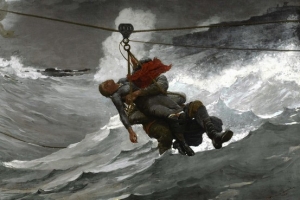
Winslow Homer (1836–1910), one of the foremost figures in American art, is well known for his sea scenes and marine paintings. Born in Boston, Massachusetts, Homer was an avid traveler and spent time living and working in New York City, Paris, and England, among other places. However, during his years in Prout’s Neck, Maine, Homer produced some of his most defining masterpieces.
Homer moved to Maine in 1883 and spent most of his time working in his studio, a former carriage house, just 75 feet from the ocean. Homer remained in Prout’s Neck on his family’s property until his death in 1910. Homer’s paintings from this period are defined by their crashing waves, rocky coasts, and his expert use of light; they are also the subjects of two current exhibitions.
The Portland Museum of Art’s show, Weatherbeaten: Winslow Homer and Maine, focuses on Homer’s connection with his Prout’s Neck studio, which the museum now owns. The paintings on display feature the ocean views Homer saw from his home as well as the burly fishermen and statuesque women he often focused on. The exhibition’s range of paintings illustrates Homer’s transition from more populated works to stripped-down paintings that include just sea and land; Homer’s personal life followed a similar evolution.
The Philadelphia Museum of Art is also hosting an exhibition of Homer’s work titled, Shipwreck! Winslow Homer and ‘The Life Line.’ The show is based around the museum’s own painting and Homer’s greatest success, The Life Line (1884), which features a woman being saved from the tumultuous sea by an anonymous hero. Shipwreck! Focuses on Homer’s changing relationship with the sea and includes tranquil marine paintings as well as bleaker scenes.
Weatherbeaten will be on view at the Portland Museum of art through December 30. Shipwreck! ends up its run at the Philadelphia Museum of Art on January 1, 2013.
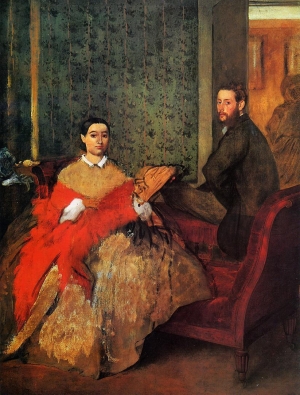
Patrons who are familiar with the permanent collection at Boston’s Museum of Fine Arts might become befuddled upon their next visit to the institution. Some of the museum’s finest works including Pierre-Auguste Renoir’s Dance at Bougival, the pivotal Claude Monet painting, La Japonaise: Camille Monet in a Japanese Costume, five works by Paul Cézanne, five more by Edouard Manet, and two of the masterpieces by Vincent Van Gogh are nowhere to be found.
While some of the works have been lent to museums in the United States, Japan, and Europe to enhance exhibitions, others have been rented to for-profit organizations. Loans between institutions are common practice, but compounded with the large number of works currently out on rent by the MFA, the museum’s own collection appears to be lacking. Currently, 26 of the MFA’s paintings are involved in exhibitions in Italy, which the institution received a hefty yet undisclosed fee for. Some of the works now on view in Italy are two paintings by John Singleton Copley and two Rembrandt portraits as well as single works by Eugène Delacroix, Paolo Veronese, Winslow Homer, John Singer Sargent, Paul Gauguin, Alberto Giacometti, and Pablo Picasso.
While the MFA is excited to be raising revenues, the act of charging fees for lending works has been a source of controversy. One of the main duties of public institutions, including art museums, is to share their collections with the public. Many objectors find the practice of lending works for profit to be in direct opposition to this goal.
Other major holdings that are not presently at the MFA are Diego Velázquez’s Luis de Gongora, two works by El Greco, two more by Gustave Courbet, the museum’s only painting by Edvard Munch, and arguably its greatest work by Edgar Degas, Edmondo and Therese Morbilli. While MFA officials argue that they are bolstering the museum’s international reputation, critics feel the institution is suffering for it.
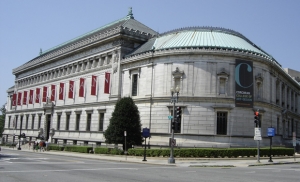
The Corcoran Gallery, Washington D.C.’s oldest art museum, has been losing money for years and is currently in need of at least $130 million in renovations. The only major museum on the Mall that is privately owned, times have been tough for the Corcoran who must charge admission and raise large amounts of money to survive. Attendance has dropped drastically and donations to the museum have roughly halved since the recession.
The Corcoran’s commanding Beaux Arts façade and top-notch collection of 17,000 works including pieces by Winslow Homer, Edward Hopper, John Singer Sargent, Claude Monet, and Willem de Kooning are simply not a big enough draw to keep the institution afloat, especially when every other institution on the Mall offers free admission. The Corcoran’s board of trustees are currently debating between a number of options to keep the museum active including selling the current building, combining forces with another institution, and moving out of the city.
While many find the loss of the Corcoran will leave the Washington Mall with a gaping hole, the museum announced that they have been discussing possible solutions with the National Gallery of Art, George Washington University, and a few other unnamed institutions. The Corcoran hired a real estate firm as its adviser in September and hopes to have its future mapped out by the first half of 2013.
The District of Columbia Historic Preservation League is looking to extend the landmark designation for the Corcoran’s exterior and interior. If the institution were approved, any major construction would be subject to public review.
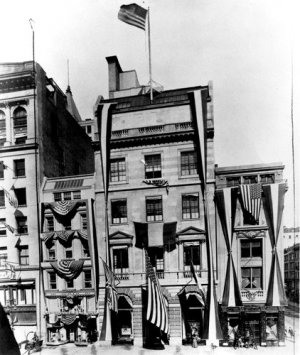
165 years ago, the Knoedler Gallery opened its doors in New York and went on to help create some of the country’s most celebrated collections including those of Paul Mellon, Henry Clay Frick, and Robert Sterling Clark. Throughout the years, top-notch works by artists such as van Gogh, Manet, Winslow Homer, John Singer Sargent, Louise Bourgeois, and Willem de Kooning passed through the gallery. When the Soviet government sold hundreds of paintings from the State Hermitage Museum in Leningrad in the 1930s, they chose to work with Knoedler to sell paintings by masters like Rembrandt, Raphael, and Velazquez.
Knoedler’s exemplary past is often forgotten as the gallery’s present has been mired in lawsuits and accusations that the company’s former president, Ann Freedman, was in the business of selling fakes. Last year, Knoedler Gallery closed its doors for good.
This week, Los Angeles’ Getty Research Institute announced that it had bought the Knoedler Gallery archive. Spanning from around 1850 to 1971, the archive includes stock books, sales books, a photo archive and files of correspondence, including letters from artists and collectors, some with illustrations. The Getty was interested in Knoedler’s archive because it offers an expansive glimpse into the history of collecting and the art market in the United States and Europe from the mid-19th century to modern times.
The archive was purchased from Knoedler’s owner, Michael Hammer, for an undisclosed amount. Meticulously preserved, the archive will be available to scholars and digitized for online research after the Getty catalogues and conserves it all.
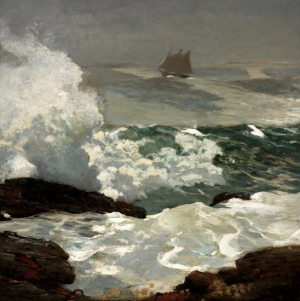
Best known for his dynamic and powerful seascapes, painter Winslow Homer (1836–1910) spent the last twenty-seven years of his life working diligently in a studio in Prout’s Neck, Maine. It was here, isolated on the craggy coast, that Winslow’s work matured and he created some of his most admired paintings. While in Maine, Homer became fascinated with the untold power of the natural world and often explored the theme in scenes of man versus nature, particularly the ocean.
Beginning September 25th, after a multi-year, $2.8 million restoration by the Portland Museum of Art, Homer’s studio will be open for public tours. After Homer’s death, the studio was passed down from family member to family member and ultimately landed in the hands of his great-grandnephew, Charles “Chip” Homer Willauer. Willauer, now 74, spent many summers living in his great-granduncle’s studio and began to worry about the future of the building. Hoping to preserve the significant piece of American art history, Willauer sold the studio to the Portland Museum of Art in 2006 for $1.8 million.
The Museum took the undertaking very seriously and went to work on renovations. The foundation was stabilized, the balcony and windows were replaced, the chimney was restored, and the exterior returned to its original green hue with brown trim. The museum ultimately raised $10.6 million to pay for the purchase and renovation of Homer’s studio as well as an endowment and educational programs and exhibitions.
To celebrate the renovation and opening, the museum will present the exhibition “Weatherbeaten: Winslow Homer and Maine,” featuring 38 oil paintings, watercolors and etchings that Homer created in his secluded studio. “Weatherbeaten” will run through December 30th.
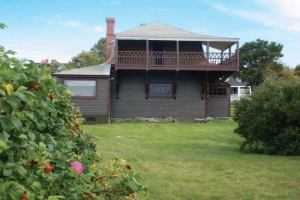
Boston art lovers might want to pencil in a trip to Maine on their calendars for next fall. Winslow Homer's studio at Prouts Neck will open to the public on Sept. 24, 2012 and should be a major new destination for cultural tourism and scholarship. The Boston-born painter, who is buried in Cambridge's Mt. Auburn Cemetery, lived and painted at the studio from 1883 until his death in 1910. It's already a National Historic Landmark.
The studio was purchased by the Portland Museum of Art in 2006 from Charles Homer Willauer, the great grand-nephew of Homer. The museum has raised $8.5 million toward a $10.5m goal to support the acquisition, preservation, and future of the Studio. It has been restoring the building to the period when Homer lived there.
"The opening of the Winslow Homer Studio will be a pivotal moment in American art history. For the first time, visitors will be able to experience the Studio as it was during Homer';s time and discover the actual location where he created his best-known paintings," Museum Director Mark H. C. Bessire said in announcing the opening.
OK, "pivotal" might be a little much, but there's no question this is big news for art lovers.
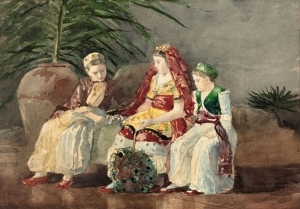
Fisherman tony Varney and his daughter Selina found an 1885 work by US watercolourist Winslow Homer outside a rubbish dump in Ireland in the 1980s. The work had apparently been abandoned. They subsequently learnt it was worth £150,000, and attempted to sell the work at auction in New York in 2009.
After learning of the sale, the painting's original owners stopped the auction, claiming the work, called Children Under a Palm Tree, was rightfully theirs. Two years on, the two families are still locked in a legal stand-off over the painting's ownership, and their story can be told in full for the first time.
"I would have willingly sat down and sorted this out," Ms Varney said. "I just don't know how long this is going to go on. I am just answering questions they are throwing at us as honestly as I can. I don't know if they are intending on striking a deal. At the moment it is just going round and round and round."
She said she was "upset" when Blake's descendants, who live at the family home in Myrtle Grove, County Cork, stopped the sale, and said the dispute had caused a "lot of heartache, a lot of grief, a lot of money".
The work shows the three children of Sir Henry Arthur Blake, a British colonial administrator who lived in the Bahamas in the late 19th century. Homer was a guest of the family and painted their children, who were holding a fancy dress party.
The watercolour remained in the family's ownership, and it travelled with them when they retired to County Cork, Ireland. It is presumed it then remained there for the ensuing decades.
However, mystery still surrounds how the painting managed to find itself outside a rubbish dump in the 1980s. While Blake's descendants claim it was stolen from their property in Myrtle Grove, they have no record of the crime taking place. Ms Varney and her lawyers argue that since her family found the work, and it remained in their possession for nearly two decades without any claim on its ownership, it now belongs to them.
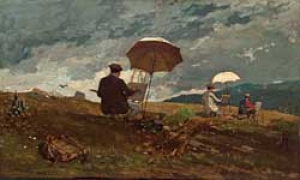
The connection between Winslow Homer (1836–1910) and the Portland Museum of Art is long-standing and intimate. Homer exhibited at the museum in his lifetime, and through the course of the twentieth century the PMA has become a symbolic home for the artist. Winslow Homer and the Poetics of Place commemorates the centennial of Homer’s death and is the first time since 1988 that the PMA’s entire collection of his work will be on view at once.
Winslow Homer lived during a time that saw the United States grow from a young country of small towns to a modern industrial nation. Throughout his lengthy career as a graphic artist, genre painter, and chronicler of the rugged Maine coast, Homer provided the nation with images that helped create a sense of place in an era of rapid change and growth. In particular, Homer’s uninhabited images of crashing waves, moody and existential, created a new way of looking at the Atlantic that proved popular to the generation of artists who followed the painter to Maine.
|
|
|
|
|